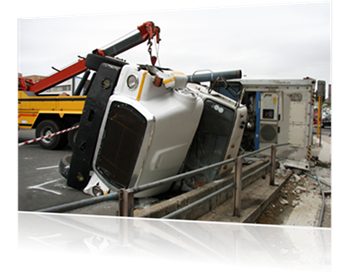The Unique Types of Accidents Involving Bucket Trucks
Jun. 10, 2020 2:43p

A bucket truck is a truck that has a long arm or "boom" with a bucket on the end of it designed to hold a people so they may be hoisted up to perform work at elevated heights. Bucket trucks are commonly used by construction companies, telephone companies, sign companies, highway tree trimmers and any company the regularly needs to lift people up at multiple locations. Depending upon how high the truck lifts people and how heavy the boom is, some larger bucket trucks have braces on the sides to help prevent the truck from tipping. Because bucket trucks are both a vehicle and a work platform, truck accident lawyers often see more variety of accidents involving bucket trucks than they see with other commercial motor vehicles. In addition to the typical truck accident that happens due to driver error, we see unique accidents that occur as a result of the truck operator's failure to warn other traffic and failure to secure cargo. We also see
electrocution accidents involving these unique trucks.
Accidents Due to Failure to Warn
When a bucket truck is working along a roadway, it will usually completely or partially block the lane of travel. On rural roads particularly, this can pose a serious hazard to other traffic traveling on the same road. The use of flaggers and/or other warning devices in to control the flow of traffic is critically important when dealing with a typical two-lane highway as this basically amounts to a construction zone. Failure to take into account how traffic flow will be affected, and plan accordingly may constitute negligence on the part of the bucket truck operator. This can result in other vehicles colliding with each other or with the workers because those drivers have not been property 'warned' with traffic control devices.
Failure to Secure Cargo
Bucket trucks are often used for replacing and repairing things at varying heights such as transformers, power cables, lights, and cameras. This means that the technicians will need to carry tools and/or replacement parts on the truck to their destination. Like any other commercial truck driver hauling a load, bucket truck drivers have a duty to secure their load. Unfortunately, we have seen cases where bucket truck drivers either were not familiar with how to secure cargo using straps, chains and/or chocs and thus, the load got loose and fell into the roadway causing a serious accident. This is considered negligence on the part of the bucket truck driver and/or his coworkers. Ultimately the responsibility for securing the cargo falls on the company who owns the bucket truck and employs the driver and technicians.
Electrocution Due to Lift Accidents
One of the most serious types of accidents that can occur involving bucket trucks is actually a work accident. When the technician operating the lift and/or moving or positioning the vehicle does not consider overhead power lines, this can be deadly for the technicians in the bucket and/or on the truck. Contact with "live" powerlines can result in severe electric shock and/or death. Our work accident attorneys have represented a worker who was negligently lifted into a powerline by a coworker. The results of this type of shock injury are life-altering.
In summary, bucket trucks are commercial motor vehicles with a unique design that can result in different accidents that the typical truck. Some of the accidents are more akin to work accident.